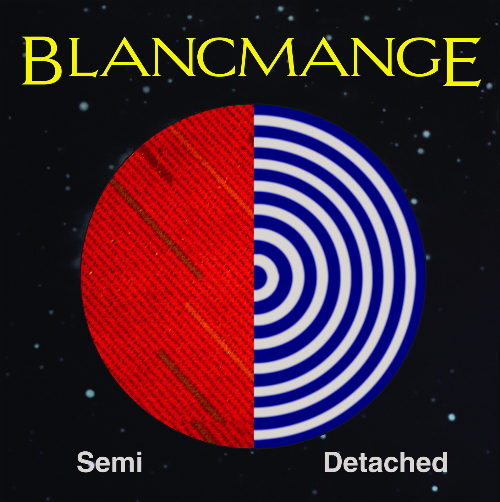Formed in 1979, in Middlesex, England, by singer Neil Arthur and multi-instrumentalists Stephen Luscombe and Laurence Stevens (who left even before they were able to record their first EP), Blancmange was one of the slew of groups that waved the flag of New Wave/Synthpop in the genres’ ’80s heyday. Unfortunately, the English band did not make the challenging journey into the decade that followed. It became one of the casualties amid the inevitable and periodic shifting of the seemingly cruel and unfair commercial spotlight. Nevertheless, the remaining duo managed to release three full-length albums—Happy Families (1982), Mange Tout (1984), and Believe Me You (1985)—and a string of hit singles that included “Living on the Ceiling,” “Waves,” “Blind Vision,” “Don’t Tell Me,” “Lose Your Love,” and “I Can See It (Why Don’t They Leave Things Alone).” Then, in 1987, Arthur and Luscombe shook hands, parted ways, and pursued separate paths. Luscombe formed an Indian-influenced group, releasing in 1989, one album under the moniker West India Company. Arthur, for his part, released a solo album in 1994. Activities came to a halt soon afterwards.
Then, after almost twenty-five years, to the pleasant surprise especially of its older fans, Arthur and Luscombe re-activated Blancmange and, in 2011, released a new album, Blanc Burn. However, Luscombe had to leave abruptly due to health reasons. Arthur decided to soldier on. In 2014, with the help of session musicians, he released Happy Families Too… as Blancmange’s fifth album—an updated re-recording of the group’s now classic debut. Obviously recharged, Arthur immediately followed this up with two more albums under Blancmange’s name, Semi Detached and Nil by Mouth, both released in 2015, with only half a year’s gap between each other.
Released on March 23, 2015, Semi Detached is Blancmange’s sixth album. It opens with the eight-minute old-school Synthpop indulgence of “The Fall,” which seems to pay homage to the pioneers of the genre, as it bears sonic similarities with the likes of The Normal’s “Warm Leatherette,” Kraftwerk’s “Autobahn,” and Orchestral Manoeuvres in the Dark’s “Messages.” Then there is the funky beat of the angular guitar–flavored “I Want More,” which can be nicely paired with The Other Two’s “Movin’ On;” while the Dark Wave atmosphere and Arabian trip of “Paddington” exudes the vibes of Red Flag’s “Broken Heart” and Camouflage’s “The Great Commandment.” In the next song, “It Didn’t Take Long,” Blancmange inevitably unleashes its Depeche Mode influences; “Personal Jesus” is all over it.
“MKS Lover” is a flight to instrumental territory…very sparse, so ambient; most likely a foreshadowing of what was to come in the next album. The mood then turns upbeat and sinister with “Like I Do,” owing to the descending chord progression and the sense of urgency in the vocal approach. “Deep in the Mine” is another trek to the black celebratory phase of Depeche Mode. Following this is the glittery, bouncy, and sparkly dancefloor stomper “Acid.” Situated near the end of the album is the poppiest and catchiest track—the engaging “Useless,” which is bursting with sugary melodies and easy-to-singalong-with chorus and carrying a similar infectious quality as Men Without Hats’ “Pop Goes the World.” Finally, the album is aptly wrapped up with the slow tempo of the ominously worded “Bloody Hell Fire.”
Overall, one might deride Semi Detached as too derivative; however, in fairness, Blancmange may be regarded as simply backtracking and digging its roots and paying tribute to the forerunners of Synthpop, the genre where it swam for decades and is still gracefully swimming to this day and age.
Following on the heels of its predecessor only after half a year, the instrumental album Nil by Mouth was released on September 25, 2015. It is more an exploratory affair than the usual Pop preoccupation of Blancmange music. It served as Arthur’s outlet for his more experimental musical ideas. Although, he had already dabbled in film scoring in the past; so, this follow-up should not be surprising to the initiated listener. The endeavor may be seen also as a similar cinematic direction that Depeche Mode’s Martin Gore has engaged in with his recently released solo album, 2015’s all-instrumental MG. By contrast though, Nil by Mouth exudes a brighter sound and features more cheery melodies instead of Gore’s somber excursions. Of the dozen tracks, standouts are the grandiose “Cistern,” which has a hint of Yanni’s equally majestic “Santorini;” the spacey and outworldly “Crystals of Zircon;” the cryptic and robotic “The Son;” a reworking of the smooth-flowing ballad “Holiday Camp;” the romantic sound and the geometric and geographic imagery of “Landsea;” and finally, the album closer, the jazzy and sexy James Bond soundtrack–worthy “Close Encounters.”
Semi Detached and Nil by Mouth serve as proofs that Blancmange, while remaining rooted in its sonic beginnings, has the confidence to put into play its more exploratory and experimental tendencies. One important aspect is certain though: Blancmange music is proudly Synthpop, and that is something that both longtime and new fans of not only the band but also the genre itself and any follower of ambient music should celebrate about. CrypticRock gives Nil by Mouth and Semi Detached 4 out of 5 stars.








No comment